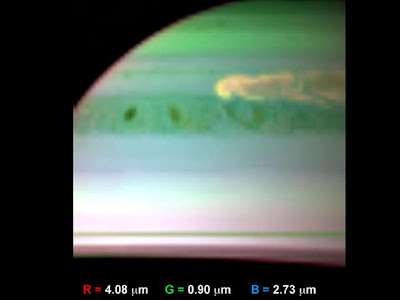NASA's Cassini spacecraft and a European Southern Observatory ground-based telescope tracked the growth of a giant early-spring storm in Saturn's northern hemisphere that is so powerful it stretches around the entire planet. The rare storm has been wreaking havoc for months and shooting plumes of gas high into the planet's atmosphere. Cassini's radio and plasma wave science instrument first detected the large disturbance, and amateur astronomers tracked its emergence in December 2010. As it rapidly expanded, its core developed into a giant, powerful thunderstorm. The storm produced a 3,000-mile-wide (5,000-kilometer-wide) dark vortex, possibly similar to Jupiter's Great Red Spot, within the turbulent atmosphere.
Cassini's radio and plasma wave science instrument first detected the large disturbance, and amateur astronomers tracked its emergence in December 2010. As it rapidly expanded, its core developed into a giant, powerful thunderstorm. The storm produced a 3,000-mile-wide (5,000-kilometer-wide) dark vortex, possibly similar to Jupiter's Great Red Spot, within the turbulent atmosphere.
The dramatic effects of the deep plumes disturbed areas high up in Saturn's usually stable stratosphere, generating regions of warm air that shone like bright "beacons" in the infrared. Details are published in this week's edition of Science Magazine.
"Nothing on Earth comes close to this powerful storm," says Leigh Fletcher, the study's lead author and a Cassini team scientist at the University of Oxford in the United Kingdom. "A storm like this is rare. This is only the sixth one to be recorded since 1876, and the last was way back in 1990."
This is the first major storm on Saturn observed by an orbiting spacecraft and studied at thermal infrared wavelengths, where Saturn's heat energy reveals atmospheric temperatures, winds and composition within the disturbance.
Temperature data were provided by the Very Large Telescope (VLT) on Cerro Paranal in Chile and Cassini's composite infrared spectrometer (CIRS), operated by NASA's Goddard Space Flight Center in Greenbelt, Md.
"Our new observations show that the storm had a major effect on the atmosphere, transporting energy and material over great distances, modifying the atmospheric winds -- creating meandering jet streams and forming giant vortices -- and disrupting Saturn's slow seasonal evolution," said Glenn Orton, a paper co-author, based at NASA's Jet Propulsion Laboratory in Pasadena, Calif. The violence of the storm -- the strongest disturbances ever detected in Saturn's stratosphere -- took researchers by surprise. What started as an ordinary disturbance deep in Saturn's atmosphere punched through the planet's serene cloud cover to roil the high layer known as the stratosphere.
The violence of the storm -- the strongest disturbances ever detected in Saturn's stratosphere -- took researchers by surprise. What started as an ordinary disturbance deep in Saturn's atmosphere punched through the planet's serene cloud cover to roil the high layer known as the stratosphere.
"On Earth, the lower stratosphere is where commercial airplanes generally fly to avoid storms which can cause turbulence," says Brigette Hesman, a scientist at the University of Maryland in College Park who works on the CIRS team at Goddard and is the second author on the paper. "If you were flying in an airplane on Saturn, this storm would reach so high up, it would probably be impossible to avoid it."
Other indications of the storm's strength are the changes in the composition of the atmosphere brought on by the mixing of air from different layers. CIRS found evidence of such changes by looking at the amounts of acetylene and phosphine, both considered to be tracers of atmospheric motion. A separate analysis using Cassini's visual and infrared mapping spectrometer, led by Kevin Baines of JPL, confirmed the storm is very violent, dredging up larger atmospheric particles and churning up ammonia from deep in the atmosphere in volumes several times larger than previous storms. Other Cassini scientists are studying the evolving storm, and a more extensive picture will emerge soon.
The Cassini-Huygens mission is a cooperative project of NASA, the European Space Agency and the Italian Space Agency. The mission is managed by JPL for NASA's Science Mission Directorate in Washington. The European Southern Observatory in Garching, Germany operates the VLT in Chile. JPL is a division of the California Institute of Technology in Pasadena.
Cassini and Telescope See Violent Saturn Storm
Subscribe to:
Post Comments (Atom)





0 comments:
Post a Comment